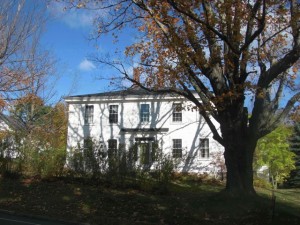240 years and counting…
By Bob Meissner, Jr. —
What’s in a house? We drive by them and speculate, like we judge books lying on the coffee table. But till you go inside, meet the people, you really don’t know. Come on in for a moment now – be surprised with its past, filled with history as much as furniture and love. Like special streets or the labels on jars of homemade preserves, today’s Parsonage, located at 1127 Main Street, in the eastern shadow of the Dublin Community Church (DCC), has had a few changes in its rich 240 years. Tied to the land like the sprawling oak that dominates the front yard, today’s Parsonage might have grown from the ground up but that’s not exactly true.
The core, the homestead let’s call it, dates from 1772 and was build by James Rollins (1730-1818) on a foundation where the DCC is now. What permeates every broad board, every square nail and each hand-wrought iron beam-rim latch set are also the stories of the occupants. Those, like James, who were born, lived, loved and fought here. I can feel the history; that Rollins signed the “Loyalty Oath” to the colonial cause in 1776; that two of his sons fought as revolutionary soldiers. Wow! Rollins never left Dublin…he’s buried in our cemetery. His homestead was sold to another 1772 Dubliner and revolutionary (Battle of Bennington) soldier, Captain James Chamberlain in 1797. Chamberlain greatly expanded the house creating this “Georgian-Federal Style, dual chimney” town centerpiece and launched an historical era for the property:
• First “pretentious” hotel (run by son Cyrus)
• Chamberlain Tavern (opened about 1812
• Post office – in the bar room (how practical!) – with Cyrus as Dublin’s first Postmaster (he was also town clerk for 28 years!)
• Stage coach stop for post riders and coaches from Keene to Nashua – with horse sheds, of course
• Here too was the first Masonic lodge in the area, est. 1815, right in the tavern (how convenient!)
• The most colorful tavern patrons may have been the Dublin Grenadiers organized in 1808
• And the building housed the Dublin Social Library and ‘Minister’s Study’ – a foreshadowing of what was to come.
In 1835 the house was purchased by Daniel Fiske (1798-1878) – who was a leader in the ‘Temperance Movement’ – ushering in a new, 120-year era (without the tavern). Fiske’s first wife, Esther, was the daughter of Moses Eaton, whose one surviving beautiful stenciled room in town remain intact in the NW bedroom of this fine establishment. The house was moved to its present location in 1852 to make room for the church and son Warren, b.1828 who held, as if by tradition, nearly every important office in the town including Town Clerk. Combined with Cyrus Chamberlain, the house was site of the town clerk’s office for 65 years!
Warren’s son Wilfred’s widow, Mabel sold the house about 1954 to Norm and Ruth Wight who sold it to the church in 1978. DCC undertook many, many renovations over the 35 years this has been the Parsonage. It’s on the market once again. New owners will buy much more than a 12-room, hardwood floor house. They will be acquiring a spotlight on a big piece of Dublin history. We’ll leave the lights on for you.
Bob Meissner, Jr., who currently resides in the Parsonage, runs MEI Search Consultants, an executive recruiting business. He is the father of two, an active member of DCC and a Keene Cheshireman.
The Advocate would like to acknowledge the Dublin Historical Society for providing research material.

